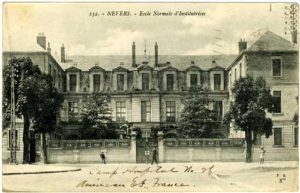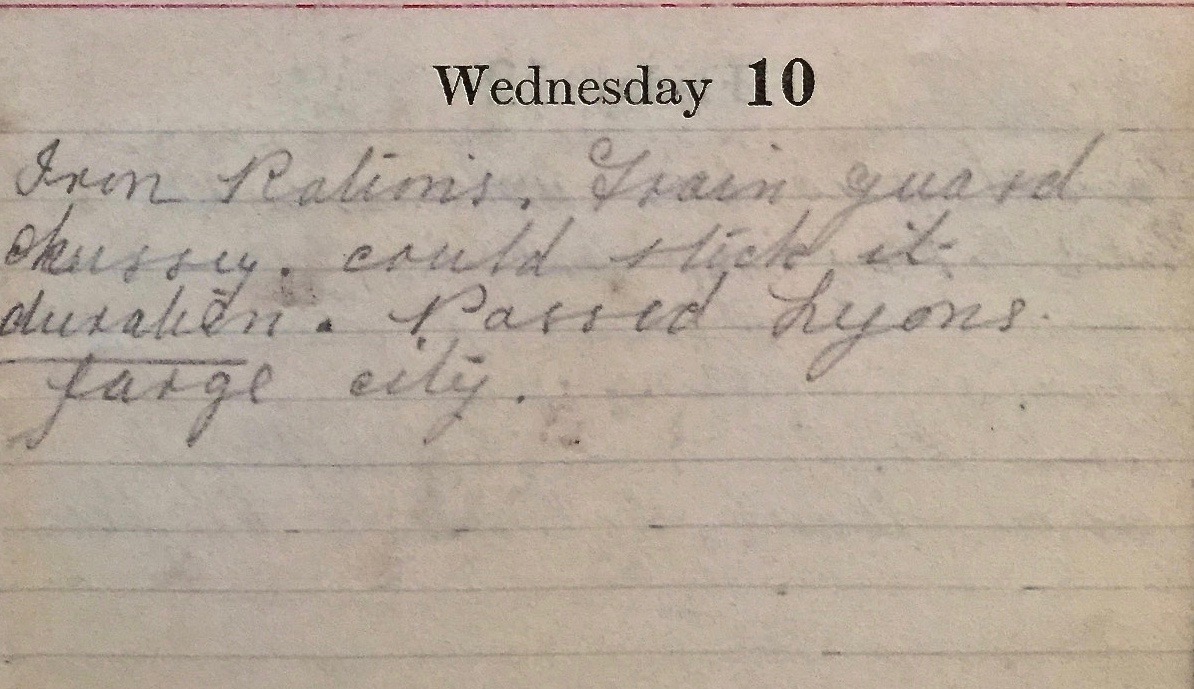Wednesday July 10th, 1918
Iron Rations. Train guard kushy. Could stick it duration. Passed Lyon – large city.
Train Guard
Frank is on duty as a ‘train guard’ today. He thinks it is a cushy role – one that he would enjoy for the duration of the war. When I read the instructions on Train Guard Duty, you can see why he might have thought this – particularly as he was heading for an unknown future on the Western Front. Here is an extract, make up your own mind:
‘Discipline
- The OC Train will place a NCO or senior soldier in charge of each coach or wagon carrying personnel, who will at once make a list of all men in his coach. The NCO or senior soldier will detail two men, one to each side of the carriage or truck, who will assist him in carrying out the train orders.
Guards
The Guards will remain armed and equipped throughout their period of duty.
General Duty of Guard
- No NCO or man is allowed to leave the train without permission
- No unauthorized persons are permitted to enter the train
- When the OC Train considers there is sufficient time to allow men to leave the train, he will give orders accordingly, and post sentries on all exists, refreshment rooms, etc, and also on all latrines to warn men when the time is drawing near for departure.
- The guard will see that the men do not straggle and will be responsible that they do not leave the Station premises on any pretext. Men will not be allowed to enter any refreshment room.’¹
Rest Camp at Nevers
Like many of the stops on this journey, Nevers can trace its history back to Roman times and has particular ties to Julius Caesar. Nevers is in Central France to the south south east of Paris.
In Nevers, at the Chapel of Saint Bernadette in the Saint-Gildard convent, it is possible to see the incorrupt body of Our Lady of Lourdes. ² ³
It does not appear that the Battalion had the opportunity to explore Nevers – so we will never know what Frank or his comrades would have made of Saint Bernadette and her city.
The Americans at Nevers
We all know that an Army ‘marches on its stomach’ & that strong supply lines are key to success in battle. In July 1917 therefore, the Service of Supply was established to support the logistical needs of the American Expeditionary Force on the Western Front. It was a sophisticated operation comprising base sections (seaport and receiving services), an intermediate section (storing and classifying supplies) and an advanced section (holding and issuing to the front lines). The intermediate section, the largest geographically, was headquartered in Nevers.

The Americans had also established Camp Hospital 28 in the city in February 1918. It was organized by the medical faculty of Vanderbilt University, Nashville. Lt Col WD Haggard, addressing the Vanderbilt Club in 1919, recalled,
‘You do not need to be reminded that out of the medical faculty there was organized our splendid Vanderbilt Unit “S,” which so successfully conducted Camp Hospital 28 at Nevers. ….When the wounded men were brought into the operating room without their uniforms, one couldn’t tell whether they were Americans, French or English.
We had over 17,000 shattered bones to mend, over 3,500 arms and legs to amputate, and 20 times that many to save.’º
With all this activity, it is no wonder that the BWD recorded that it ‘Met the first American troops’.
13th (Service) Battalion War Diary – 10th July 1918 – St Germain, France
Arrived 09:10hrs. Battalion marched to Rest Camp for breakfast entraining again at Nevers (22:30 hrs). Met the first American troops.
References & Further Reading
¹ Extract from ‘Orders for Train’, BWD for June, Attachment IV. This document was read out to the men before departure.
² Nevers on Britannica
³ Nevers on Wikipedia
º —Lt. Col. W.D. Haggard, February 1919 address to the Vanderbilt [University] Club of Nashville
† Camp Hospital 28, Office of Medical History
* postcard of the school which became Camp Hospital 28, image may be subject to copyright


